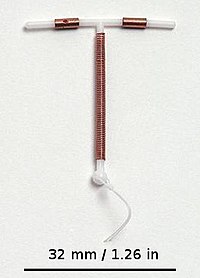
Photo from wikipedia
OBJECTIVE To assess the value of the direct insertion technique compared to the conventional insertion technique in reducing the pain experienced during placement of an intrauterine device (IUD). METHODS A… Click to show full abstract
OBJECTIVE To assess the value of the direct insertion technique compared to the conventional insertion technique in reducing the pain experienced during placement of an intrauterine device (IUD). METHODS A prospective, controlled, randomized, single-blind trial was conducted in women eligible for IUD insertion. Participants were randomized into two groups: "conventional placement" and "direct placement". The primary endpoint was the percentage of women reporting pain scored as ≥ 4 on the Numerical Verbal Rating Scale (NVRS) at IUD release. Secondary endpoints comprised the number of immediate incidents (insertion failure, vasovagal reaction, and IUD expulsion), the correct positioning of the IUD, checked by ultrasound, the occurrence of incidents within the week following IUD insertion, and the operators' evaluation of the procedure. RESULTS A total of 60 patients were enrolled. During IUD insertion, 27 women (45.8%) reported an NVRS score ≥ 4, 32.1% in the "direct placement" group and 58.1% in the "conventional placement" group (p = 0.07). The median NVRS pain scores in the "direct placement" and "classic placement" groups were 2 and 4, respectively (p = 0.01). No statistically significant between-group differences were found with regard to the secondary endpoints. CONCLUSION Use of the direct technique reduced the pain experienced during IUD placement. We observed a trend towards a decreased proportion of patients reporting an NVRS pain score ≥ 4 at IUD release with use of the direct technique and the median pain intensity scored on the NVRS was significantly lower in this group. The two techniques did not differ with respect to complications.
Journal Title: Journal of gynecology obstetrics and human reproduction
Year Published: 2019
Link to full text (if available)
Share on Social Media: Sign Up to like & get
recommendations!